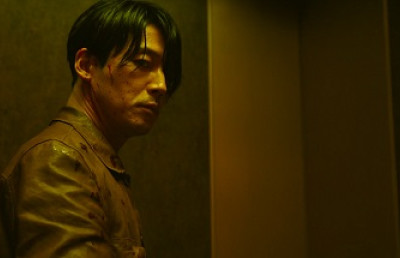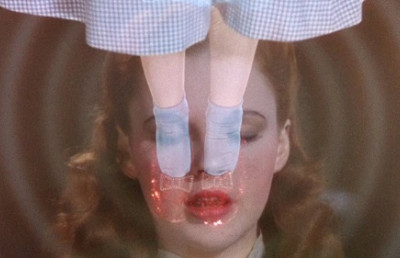‘Game Horror’ as a Reflection of America
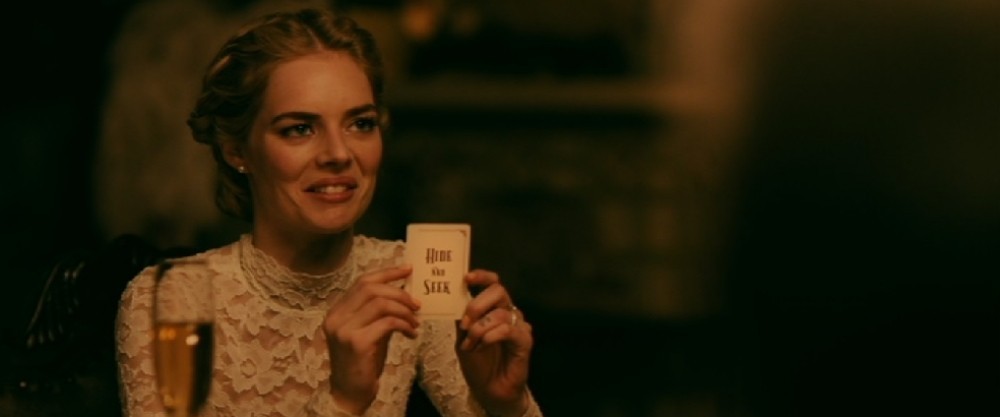
Introduction
Over the past decade, there have been a number of financially successful horror films that use popular physical or childhood games as their source material, examples of which include Guy Levy’s Would You Rather (2012), Nick Simon’s Truth or Dare (2017), Jeff Wadlow’s Truth or Dare? (2018), Matt Bettinelli-Olpin and Tyler Gillett’s Ready or Not (2019) and Adam Robitel’s Escape Room (2019). Although not strictly a game in the traditional sense of the word, the two films in the Ouija series, Ouija (Stiles White, 2014) and Ouija: Origin of Evil (Mike Flanagan, 2016), can also be included in this category. 1 These have been accompanied by films that incorporate game motifs, or use games as significant plot devices through which they can torture or eliminate their players – the two major examples here are Unfriended (Leo Gabriadze, 2014) and Jigsaw (Michael and Peter Spierig, 2017).
The concept of films inspired by games or incorporating game elements is certainly not a new one, but this past decade has seen a minor explosion in what I will term ‘game horror’. This essay will analyse these films, asking why such films should emerge predominantly within the US horror cinema of the 2010s. It will discuss some of the existing work on theorising games, and use the definitions provided by game scholars to paint a picture of a horror cinema that is fundamentally concerned with order and the shifts in American society. Through a close analysis of both Ready or Not and Truth or Dare?, we will see how game horror is reflective of an increasingly polarised America – a country governed by systems which seem to work to the benefit of certain societal identities, and which leaves others feeling trapped in a game that is rigged against them and which they cannot possibly win. By framing contemporary America through the lens of games, it indicates a society that requires winners and losers and, through the instillation of a discourse based on competition, a sense of ‘us’ and ‘them’.
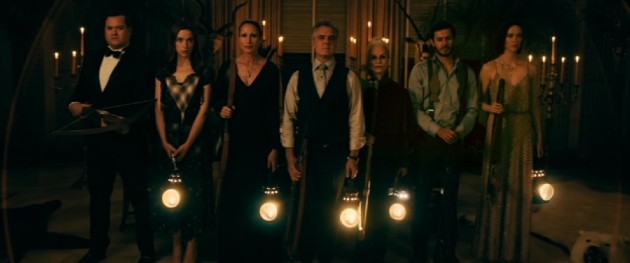
Le Domases ready to play Hide and Seek
What are games?
In order to discuss game horror, it is first necessary to understand exactly what we mean by a game. In his introduction to Les Jeux et les hommes, French sociologist Roger Callois defines the game as follows: “Any game is a system of rules. These define what is or is not a game; that is, what is allowed and what is forbidden. These rules are at the same time arbitrary, imperative, and without appeal. They cannot be violated on any account, or else the game ends immediately and is destroyed by the same fact” (Callois 11-12, my translation). In their foreword to the seminal Rules of Play, Katie Salen and Eric Zimmerman write that “a game is a system in which players engage in an artificial conflict, defined by rules, that results in a quantifiable outcome” (Salen and Zimmerman 80). Similarly, for Bernard Suits, the nature of a game is defined by the rules that define it: “To play a game is to engage in activity directed toward bringing about a specific state of affairs, using only means permitted by specific rules, where the means permitted by the rules are more limited in scope than they would be in the absence of the rules, and where the sole reason for accepting such limitation is to make possible such activity” (Suits 150).
These definitions make reference to conflict and competition. This conflict can take multiple forms depending on the structure of the game, with examples including: single or multiple players against the game itself, team competition, unilateral competition (where one player is against several others), multilateral competition (in which every player is in it for themselves) or player versus player (Fullerton 51-56). Competition in games is typically characterised through three main traits: it involves a structured rule set; it engages players with mutually exclusive goals (of which only one player/team can achieve within a contest); and it often produces an end-game result that reveals clear winners and losers (Adams; Boxill 108-115). In game horror, the prize is typically a character’s life and, to win the game, they must outlast or eliminate the other competitors. In David Guy Levy’s Would You Rather (2012), for example, the win condition of the game is to be the last surviving player.
Using this framework, we can discuss how the game manifests within contemporary horror. Reference is typically made to playing a game, and a clearly defined ruleset is set out for the characters. They will choose to play the game, thus putting them in the power of a supernatural or human being who could roughly be equated to the gamemaster – this figure governs the game, and punishes those who break the rules. The characters will realise that they must conform to the ruleset and play the game in an attempt to complete an objective, which is normally to save their own lives. Progression through the game will see many of the players eliminated, and the final stages will see the surviving players in a confrontation with the gamemaster. The game either claims the lives of the players or, if they succeed, the film implies that a resumption of the game will soon follow. Ouija: Origin of Evil ends with a flash-forward to the events of the next film, and Ouija concludes with main character Laine (Olivia Cooke) discovering the Ouija board planchette, indicating the circularity of such games. Part of the horror of this trend is that it is seemingly impossible to ever truly win, and the rules will swiftly be re-established.
Why has game horror emerged now?
It has long been theorised that the horror genre should be read as a reflection of societal and cultural fears, allowing audiences to engage with the traumatic legacy of the recent past 2 . Scholars of contemporary US horror cinema argue that the genre is reacting to a polarised and angry climate that is linked, in large part, to the hard-line and right-wing politics of Donald Trump’s Presidency – as Victoria McCollum writes, the genre is rapidly and effectively responding “to the events, anxieties, discourses, dogmas, and socio-political conflicts of the Trump years” (McCollum 3).
In my work on authoritarian horror, another subgenre that emerged over the past decade, I argued that the films I discussed reflected the socio-cultural tensions inherent in contemporary US society. The films did so through the relationship between the obvious villain character (who is defined through power and control, and who seeks to impose order) and their victims. These victims are either morally dubious or they in some way reflect real-life social issues, and this complicates the protagonist-antagonist reading. There is a threat to society and its structures in these films, but the exact nature of that threat is open to interpretation: “Does the threat come from the actions of the authoritarian character, or are they necessary as a response to the threat posed by the social issues the victims represent?” (Goodall 126-127). Through this dual understanding, authoritarian horror responds to an increasingly polarised political climate, in which the conception of societal disorder is different depending on the ideological viewpoint of the observer. Whichever the chosen interpretation, both articulate the same fundamental concern – how America and its governing institutions have reacted to shifts in the country’s societal fabric.
If we understand games as formal systems that necessitate adherence to a set of clearly-defined rules, then their emergence is explicable for a similar reason. Much like authoritarian horror, the appeal of games horror is that it too represents a desire for order, which is in this case defined by the rules of the game that the characters play, and asks exactly what shape that order should take. Typically, these films begin with the characters and the audience being provided with a set of rules, and they are punished (often fatally) for breaking these rules. In many of these films, the games are zero-sum – there can only be one winner, or at least this is how the players imagine the games. One example of this is the final game in Jigsaw, in which two players are chained up and told a shotgun is their key to escape. Although the solution is that the key is contained within the shotgun cartridge, one of the players, Anna (Laura Vandervoort) immediately leaps to the conclusion that in order to win, she must eliminate the other player. The gun is rigged to backfire, killing her and destroying the other player’s key. As a result, they both die. This is indicative of a certain societal attitude, which values individualism over collectivism.
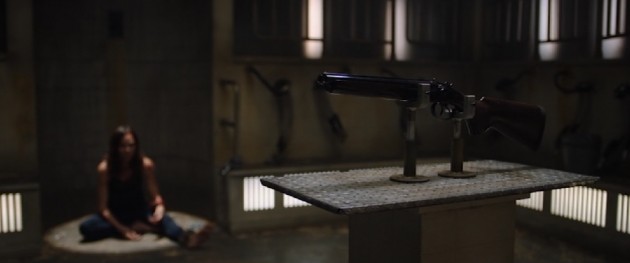
Jigsaw, the Shotgun Game
The nature of rules seems to imply the existence of authority – an authority to set rules, to enforce them and to penalise those who break the rules. In the game horror filmography, there is a clear pattern to the types of societal identity and mindsets that the rules favour: most predominantly, characters who are white, male and part of heteronormative family units; those who view games as a system through which they can perpetuate or resurrect this existing patriarchal societal structure; and those who see games as a means of punishment for those who deviate from wider societal rules (those who are criminals, for example). Any living example is a white man, while the female and foreign gamemasters are paranormal entities, this degree of difference nullifying the discrepancy that they their actions help defend the dominant patriarchal order. White men are the identities that have traditionally benefitted from existing norms in America, and are consequently the identity group that is most at threat from advances in gender mobility and the impending minority status of whites. Thus, by imbuing this particular identity with authority, the implication follows that other identities necessarily miss out in the construction and restoration of a certain societal order. As sociologist Michael Kimmel writes of white men, “what we think of as ‘fairness’ to us has been built on the backs of others”, resulting in a sense of “aggrieved entitlement” as the identity group “refuse[s] to even be dragged kicking and screaming into that inevitable future” of greater gender and racial equality (Kimmel).
As Simon Kuper writes, contemporary American politics has essentially become defined by the battle between identities, to the extent that parties have realigned around ethnic and religious, rather than ideological, bases. Political positions matter less than the sense that the Republicans are catering to an older, rural, white religious voter, while the Democrats’ constituency comprises younger white people and minorities. 3 Opposition between political parties is nothing new, but the rhetoric against the opposing side – the opposing team, to use game terminology – has become hyper-charged in recent years, and the gap between different ideologies has become increasingly large. This has a major impact on relations between citizens – as Robert B. Talisse writes, “with political disputes magnified and amplified by disparate, even opposing, ways of life, it’s harder to see political rivals as fellow citizens” (Talisse).
It is perhaps unsurprising that a game mentality should be made explicit with the tumultuous ascension of Donald Trump to the presidency 4 . Trump’s reputation as a figure in popular culture was linked in large part to his role as host of The Apprentice (2004-2015, although it continued with Arnold Schwarzenegger). The show, a competition to find a new employee for one of Trump’s businesses, was structured like a gameshow: it saw teams compete with each other in a series of challenges, and one contestant (or player) was eliminated each week. The winner would be determined through a combination of objective measures (who made the most money, say), but also by the subjective opinion of Trump, implying that the attainment of socio-economic power in America is not simply the result of hard work, but also necessitates currying the favour of those who already possess power. There are clear rules, but also unwritten ones, that govern our behaviour and relationship with authority. As Carter (Landon Lieberon) tells the main characters in Truth or Dare?, “tell the truth, or you die. Do the dare, or you die. Refuse to play… just follow the rules” – the only way to survive is to follow the rules, essentially obeying the implicit desires of those with power.
Trump’s campaign was full of rhetoric referring to law and order, including his desire to build a wall between the USA and Mexico to reduce an alleged wave of crime, his calls to deport 11 million illegal immigrants and his idea to create a database to track Muslims. His slogan, ‘Make America Great Again’, is evocative of a certain American past, white and male-dominated. Furthermore, as the line was employed by Ronald Reagan in the 1980 presidential election, it implies the Trump administration could be read as an attempted revival of a Reaganite ideology, which projects US strength and deals with threats to societal order (Goodall 124-125). That the Trump campaign evoked order and a nostalgic view of the past is not a new observation – for our purposes, it is instructive to highlight how Trump employed the language of games during his presidential run. During a 2016 campaign rally, Trump told a crowd: “We’re going to win so much, you may even get tired of winning, and you’ll say ‘please, please, Mr President, it’s too much winning! We can’t take it anymore!’” Trump thus draws a connection between the restoration of a particular form of societal order and winning a game and, through the evocation of his role in The Apprentice, implies that the president is comparable to a gamemaster. 5
If we align the games with the structures of US society, we can identify the socio-cultural tensions inherent in game horror texts – the need for order, coupled with an increased awareness of how existing institutions of how the rules that support this order creates a tiered system of identities. Game horror posits a zero-sum system in which the success of some necessarily comes to the detriment of others. Through an analysis of Ready or Not and Truth or Dare?, we can see how the game horror trend discusses some of these societal questions, asking exactly how the imposition of a certain kind of order has created a divide in America. These two films should both be read as articulating the concerns of a lost portion of US society, which lacks the potential for upward mobility and which is trapped in a game that feels increasingly impossible to win.
Ready or Not
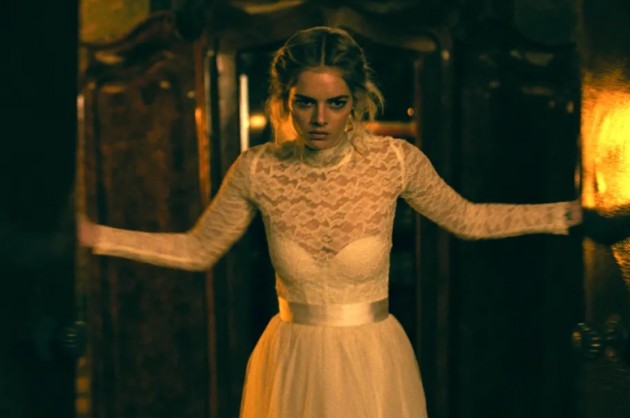
Matt Bettinelli-Olpin and Tyler Gillett’s Ready or Not (2019) is a film concerned with games, and the way in which they reinforce existing power structures. It follows Grace (Samara Weaving), who marries into the wealthy Le Domas family. On her wedding night, she is told she must partake in a family tradition – as the Le Domases made their fortune in games, every new family member must draw a card from an old puzzle box and play whichever game is named. Grace draws ‘Hide-and-Seek’. She conceals herself within the mansion, while the Le Domases arm themselves with antique weapons to hunt her down.
The Le Domas’ fortune and their status in the world is defined though their control of games. As Grace’s fiancé Alex (Mark O’Brien) tells her, the family prefers to be thought of as a “dominion”, a word loaded with connotations of control. The Le Domas family run a gaming empire, and are able to benefit from a system of gaming because their great-grandfather Victor was able to win a game. As patriarch Tony (Henry Czerny) describes the family history to Grace, the story he provides is evocative of the American dream: the “dream of a land in which life should be better and richer and fuller for everyone, with opportunity for each according to ability or achievement, […] a dream of a social order in which each man and each woman shall attain to the fullest stature of which they are innately capable, and be recognised by others for what they are, regardless of the fortuitous circumstances of birth or position” (Truslow Adams 214-215). We learn that Victor was a merchant seaman, and it is implied that he was a foreigner who transitioned into societal and economic success as a result of winning a bet with Mr Le Bail (implicitly the Devil). This sequence makes a clear connection between games and success, and one of the foundational ideas of US life.
Grace’s death in a game of Hide and Seek is stated to be necessary because it helps reinforce a particular status quo: one that is white, heteronormative and patriarchal, and based around an inherently classist system that encourages a mentality of ‘us’ and ‘them’. As Charity Le Domas (Elyse Levesque) remarks, Grace will “never be one of us”. Although her personal history is never made explicitly clear, we learn that she never had a family and it is suggested that she came from poverty, implicitly from a care home. The wealthy Le Domases control the system and, if Grace is able to successfully assimilate into the system by winning the game, the distinctions between ‘us’ and ‘them’ collapse: as Alex’s brother Daniel (Adam Brody) notes, “the rich really are different”, and the very structure of the game perpetuates this difference. In other words, the system must discriminate because the game necessitates winners and losers – in a simple oppositional game, if Grace wins, then the Le Domases must necessarily lose, thus destroying their sense of control.
This is alluded to throughout the film. As Tony explains the rules of Hide and Seek to Grace, she makes the wry observation that “there’s no way for me to win” – although the two of them laugh, the line is indicative of a feeling that the system is rigged against Grace (and, by extension, those who are young and poor). Whereas other members of the family have played games in the past to join the Le Domases, the historic possibility afforded by the American Dream appears remote and unattainable for Grace. There is literally no way for Grace to win the game in a way that furthers the existing power structure of the family: the deal made by Le Bail requires a sacrifice whenever this particular card is pulled, and thus Tony begins to panic that he will be unable to fulfil his side of the deal as Grace escapes. He admonishes his family: “Do you realise that if she lives till dawn, that we’re all going to die?” He then cites the example of another wealthy family, who have apparently been eradicated in a similar circumstance. Fulfilling Le Bail’s deal will save the family from death, and it also preserves their wealth and status, implying a certain relationship between the two.
Despite the pretext of welcoming Grace into the family, Tony angrily tells her that “you’re just another sacrifice. You’re another goat”, indicating the distinct class repression that is necessary to sustain the status quo. This class dynamic is suggested as the family’s maids are unceremoniously killed by the Le Domases. The three characters are of similar physical appearance and wear identical outfits, and several members of the family struggle to tell them apart. They are all accidentally killed, two by Emilie Le Domas (Melanie Scrofano) and one by Grace, and the deaths are played differently for the audience. Emilie’s accidental murders are sequences of comedy, which focus on her overwhelmed reaction instead of her victims – it implies that the waitresses are disposable, treated almost like disposable pieces on a gameboard. By contrast, Grace attempts to save Dora, the waitress she encounters, in what could arguably be read as a show of class solidarity on her part. This gesture is not reciprocated by Dora, however, who tries to shop Grace to the family in order to save herself – this conflict represents the ugly side of the rat race, the feeling of an inherent competition between the poor. The Le Domases rely on people like Grace and the waitresses to consolidate their position, but these lives are disposable as a result. Tellingly, Dora looks to the Le Domas mansion for safety as the game begins, but this is a physical domain built on the repression and destruction of people like her – thus, she is crushed by the dumbwaiter, a literal victim of the space afforded by those who control the game.
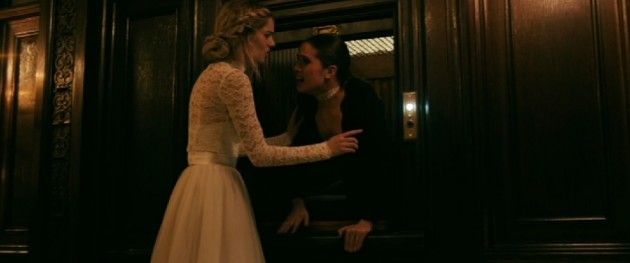
Ready or Not-Grace Tries to Save Dora
Their bodies are removed by the family and taken to a barn, where they are thrown into a disposal pit with goat carcasses and the remains of the last victim of Hide and Seek. The implication is that, like the sacrifices required to maintain the Le Domas line, the waitresses are considered disposable – indeed, as Tony’s words make clear, they could even be understood as animalistic, or sub-human. 6 This final resting place is an outbuilding separate from the main house, suggesting a distinction drawn even in death. It is necessary to repress and destroy the lower classes to preserve a certain societal order and, the act accomplished, it can be forgotten about, cast out of mind as the bodies of the victims are cast into the goat pit.
But it is Grace who wins the game, surviving until sunrise, and so Le Bail punishes the family for their failure. In a comically absurd sequence, the Le Domases explode, and Grace exits the family’s burning mansion. The deal agreed by Victor Le Domas gave the family control of the system on the condition that they were able to continue the repression necessary to sustain it. Unlike most game horror films, however, Ready or Not offers a subversive ending – the very structure of the game is destroyed and, with it, the societal structure that the game works to reinforce quite literally burns to the ground. Up to the very end of the film, there is a coherent sense of ‘us’ vs ‘them’ and, in a triumphant moment, Grace demands a divorce from Alex, who betrayed her to protect himself. Charity’s observation that Grace will never be one of them is an astute one behind it underlines the inherent tension behind the film – if Grace is able to win the game, transcending the barriers of age, gender and class in the process, then the dominant societal order is weakened and potentially even destroyed as a result. Ready or Not employs its game imagery to depict a stalled dream of societal mobility.
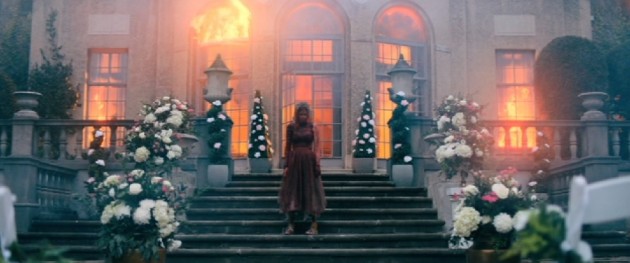
Ready or Not-Le Domas Mansion Burns
Truth or Dare?
Jeff Wadlow’s Truth or Dare? is a film positing a game that is dangerous and all-powerful, and its young victims as completely lacking in agency – much like Grace, our main characters face a system that is rigged against them and which they seemingly cannot survive. It follows a group of friends, who head to Mexico on their final spring break. They encounter a young man, Carter (Landon Liboiron), who takes them to a convent and traps them in a possessed game of Truth or Dare. When the friends return home, they are followed by a demon, who forces them to continue playing along – if they fail to tell the truth or complete their dare, the game turns fatal and makes the player kill themselves. As the number of players decreases, Olivia (Lucy Hale) and her best friend Markie (Violett Beane) attempt a ritual that would capture the demon and save their lives but, when the spell goes wrong, they spread the curse around the world to help protect themselves.
The entity behind the game is first invoked in Truth or Dare? to deal with the failure of an institution. The characters learn that the demon was summoned in order to protect some young nuns from a sadistic and abusive priest, who tormented the girls in his care. Yet, even prior to this revelation, institutions have proven ineffectual and, in some cases, actively harmful for the main characters, thus forcing us to question the systems that govern their lives (and, by extension, our own). As the game begins to eliminate the players, they become the subjects of a police investigation. Detective Kranis (Gregg Daniel) interviews Olivia and tells her that he is seeking to understand what is going on in order to help, but he is presented as an obstacle for the group to overcome rather than a potential saviour figure. The demon then manifests throughout various institutional forms – the police radio, a medical school representative, a father, even the physical infrastructure that makes up their neighbourhood – and its ubiquity is indicative of the danger of these societal pillars.
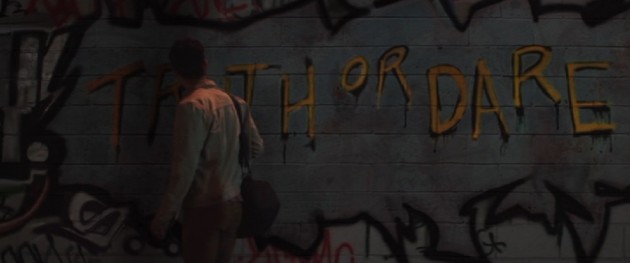
Truth or Dare-The Demon Becomes Part of Societal Infrastructure
Institutional figures have negatively impacted the lives of several main characters. Brad (Hayden Szeto) is gay, but unable to reveal that fact to his father, a police officer, until he is forced to do so by the game. In a later turn, he is dared to steal his father’s gun and to force him to beg for his life. As Brad demands that his father beg, the officer holds an entirely different conversation in order to deescalate the perceived threat. It is tempting to read this sequence as representing the fundamental divide between Brad and his father, and their total inability to openly communicate with each other. Officer Chang’s failure to understand and help his son is an indictment of a perceived collapse of the traditional father role, and it ultimately proves fatal to Brad – he is shot and killed by another police officer, in what could be seen as a subtle imposition of law and order.
Failures of fatherhood have also shaped Markie’s life. We learn that her father took his own life prior to the events of the film, and it is clear that the tragedy still haunts her – references to her father cause her to react angrily, something Olivia uses to goad her in one of the dares. Markie retains two physical memories of her father, both of which are indicative of his failure to conform to a successful paternal role in a nuclear family structure: a video of him making jokes as he accidentally ruins some barbequed food, and the gun he used to kill himself. Olivia is later forced to reveal a secret about Markie’s father. On the night he died, he had lost his job and, in drunken desperation, he attempted to sexually assault Olivia (we never learn what happened to Markie’s mother, but it is implied that Markie was raised by her father alone). From what we learn of Markie’s father, then, his character meets none of the characteristics of the paternal role – he is head of a broken nuclear unit, unable to provide or care for his child and, with his death, unable to protect her from the world. Her father’s death is symbolic of the decline in the power of the white man, but also of the way in which the failure of traditional US institutions continues to impact on the lives of society’s young. 7
The restoration of order in game horror implies the restoration of a certain kind of order, but the demon game in Truth or Dare? instead represents a further breakdown in order. The nun who invoked the demon’s power in the first place as a means of dealing with a subversion in order (by the priest) is forced to also contend with the demonic threat to order after the priest has been killed – the demon, although used as a punitive force, does not right the injustice of the priest and continues to torture the nuns. The return to an established order is one in which a foreign woman can be afforded little societal power – for our purposes, she is on the wrong team to help reset and police the rules. Thus, she must disempower herself, removing her own agency by cutting out her tongue. 8
The question of choice and agency recurs throughout Truth of Dare?, even before the group of friends are trapped in the game. Olivia is essentially forced to go to Mexico when her friends offer her a choice – she can go to help an impoverished region by herself, or take her friends for added manpower. Although she is given the pretext of an option, the sequence is framed in such a way that we are in no doubt what Olivia must choose. Later, when Markie is dared to break Olivia’s hand, Olivia provides her friend with a hammer, stating that “you really don’t have a choice”. In this second example, the lack of choice is a consequence of playing the game, but this situation in fact predates Truth or Dare – Olivia’s life is already governed by the illusion of freedom, and the game merely exploits this to its own end.

Truth or Dare-Olivia Demands Markie Break Her Hand
As the group sit in the convent, they play a game of hypothetical questions. Brad offers this hypothetical to Olivia: “Aliens invade Mexico, and they give you a choice. They kill all of us and leave peacefully, or they kill half the population of Mexico and we escape, unscathed… choose.” Olivia takes the first option, because “there is no other right answer”. She positions herself as an altruistic figure in the hypothetical realm, but she acts differently in practice. At the end of the film, only Olivia and Markie are left alive, and they are faced with another choice – the game can continue until it kills them both, or they can bring other players into the game, essentially dooming other lives to protect themselves and delay their next turn from taking place. They choose the second, sending out a viral video that traps people around the world in the game.
Faced with the choice of ending the game or perpetuating an existing harmful system, Olivia is conditioned to choose the latter – she has no true societal agency, a player with no real power within the game. As Markie tearfully tells Olivia as the game goads her to kill herself, “the game has us”, reflecting the despondency of a generation with no power over the systems that govern their lives. Unlike Ready or Not, Truth or Dare? offers no hope of salvation or systemic change – the horror emerges because the players realise that they are in a game system that will always control them until they die.
Conclusion
The emergence of the game horror trend, and the use of game motifs and imagery in contemporary horror, is reflective of an increasingly polarised climate in America. The integral elements of games – the need for rules (and enforcement of those rules); the idea of success through competition – can be extrapolated to a societal level. Games and the gamemasters are coded as representative of the institutions that govern US society, making them horrific in the process and thus forcing the viewer to confront the (negative) roles that these institutions play in their lives. Similarly, by aligning us with protagonists who are trapped in a system entirely outside of their control save certain arbitrary gestures, we are encouraged to think about agency and mobility, and the very nature of freedom.
We can see that the imposition of games is indicative of a need for order, the same desire that helps to partially explain Trump’s election to the presidency. This order is characterised as simple and highly punitive, and with the intention to protect or reassert an established shape of society. It works through depriving large swathes of the population of mobility, agency and control over their lives, and thus game horror paints a picture of society in stagnation, in which a (dying) established order fights to protect itself and proves harmful to other members of America as a result. By making stark the contrast between winners and losers, between ‘us’ and ‘them’, the game horror trend demonstrates that the idea of a fair and equal USA, in which all men are created equal, is highly at odds with the present reality.
Game horror indicates the malaise of contemporary America – it frames society as a zero-sum game which necessitates winners and losers (and thus, a sense of individualism rather than collectivism), it strips its players of agency and imbues certain institutions and identities with near-total and punitive power over the lives of others. By making these divisions so stark and destructive, the game horror trend demands that we reflect on what it truly means to win in a game rigged against so many of its players.
This essay was submitted in October 2021
Bibliography
Adams, Ernest W., Fundamentals of game design, second edition (Berkeley, CA: New Riders, 2010).
Boxill, Jan, ‘The ethics of competition’ in Jan Boxill (ed.), Sports ethics: an anthology (Malden, MA: Blackwell Publishing, 2003), pp. 107-115.
Callois, Roger, Les jeux et les hommes (Paris : Gallimard, 1958).
Fullerton, Tracy, Game design workshop, second edition: a playcentric approach to creating innovative games (Burlington, MA: Morgan Kaufmann Publishers, 2008).
Goodall, Reece, ‘John Kramer for President: the rise of authoritarian horror’, Horror Studies 11:1 (April 2020): 123-140.
Kimmel, Michael, Angry White Men: American Masculinity at the End of an Era (New York: Bold Type Books, 2017).
Kuper, Simon, ‘How far will US polarisation go?’, Financial Times (27 February 2020), accessed online at https://www.ft.com/content/d3159f4a-582f-11ea-a528-dd0f971febbc.
McCollum, Victoria, Make America Hate Again: Trump-Era Horror and the Politics of Fear (Abingdon; New York: Routledge, 2019).
Salen, Katie, and Zimmerman, Eric, Rules of play: Game design fundamentals (Cambridge, MA: MIT Press, 2003).
Suits, Bernard, ‘The elements of sport’ in W. J. Morgan and K. V. Meier (eds.), Philosophic inquiry in sport (2nd edn.: Champaign, IL: Human Kinetics Publishers, 1995), pp. 8-15.
Talisse, Robert B., ‘Partisan divide creates separate lives’, The Conversation (20 September 2019), accessed online at https://theconversation.com/partisan-divide-creates-different-americas-separate-lives-122925
Truslow Adams, James, The Epic of America (Boston: Little, Brown, and Co., 1931)
Notes
- They do share certain commonalities with the other films, including the imposition of a rule set and a game space. Most interestingly, the two films were produced by toy and game company Hasbro. ↩
- There is a significant amount of scholarship unpacking the implications of Vietnam-era and post-9/11 horror cinema. ↩
- This is not to imply that political stance is completely irrelevant, but the fact that the two parties have retained almost all of their voters despite some radical policy shifts in the past decade suggests that identity is of larger importance for a significant portion of American voters. ↩
- Of course, in a way, the presidential election is itself constructed like a game, in which there can clearly only be one winner. ↩
- The fact that all of the games used as foundation for the game horror trend are those of childhood is instructive, another indicator of the connection between American nostalgia and game mentality. ↩
- In Jigsaw, Kramer traps his players within an old farm, inviting a similar reading. ↩
- Tellingly, the game takes the form of Markie’s father in an attempt to goad her into killing herself, essentially using the failure of the past to destroy Markie’s future. ↩
- That the nun is Mexican, and that the group were possessed south of the border, suggests that a threat to order has a distinctly foreign property. In a political climate in which Mexicans are demonised by President Trump as inherently threatening to American life, and the film’s negative climax involves the interconnectedness of the globalised world, this is a potentially potent symbol. ↩





